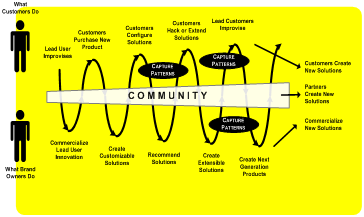Customer Innovation Guide: Core Competency 4
Mastering the Fourth Core Competency: Opening Up Product Development
How far along are you in the Open Development Continuum? Do you empower, encourage, and reward customers for extending your products, coming up with new products, and sharing their solutions with others? See how you’re doing in this self-assessment guide.
Determining How Far Along You Are in the Open Development Continuum
In my book, "Outside Innovation: How Your Customers Will Co-Design Your Company' s Future," we specify the five core competencies to master:
- Story-Telling
- Community Building
- Customer Co-Design
- Open Development
- Peer Production and Peer Promotion
For each competency, we provide context and a list of activities (methods/behaviors/programs) you should be implementing to reinvent your organizational culture around customer-led innovation. We also provide you with space to complete your self assessment: how well is your organization/division/department/group doing on fulfilling these requirements? We recommend that you identify those activities broken down into three categories (which mirror our Customer Scenario ® Mapping methodology):
- Things "We Can" Do—you already do this activity well.
- Things "We Will" Do—you have already identified this activity as strategic to your organization, and you have a plan for implementation in place, complete with a budget and delivery date.
- Things "We Should" Do—you aren' t currently committed to this activity, but you understand that you should investigate it and prioritize its value to your customers and to your organization.
Finally, we provide a place for you to make note of your next steps for each activity. We recommend that you include the name of a person who is to take responsibility for the next action as well as a target deadline for completion of that action.
COMPETENCY 4: Open Development
The business world has changed. Maintaining a veil of secrecy about new ideas and product plans doesn' t cut it in the era of full disclosure. Oh, sure, this is a slippery slope to navigate—how do you create a competitive advantage if you put all your ideas out there for everyone to see?
We' re not advocating complete public disclosure of your breakthrough concepts. But don' t wait until your products and business models are "baked" before you invite customers to alpha or beta test them. Don' t limit customer engagement to usability testing or focus groups commenting on the user interface. The earlier in the product development cycle you engage your outside innovators—your customers in the roles of lead customers and consultants—the more likely that your products will reflect their needs and address their frustrations.
Nurture Lead Customers and Customer Consultants . 1 So what' s the difference between the two customer roles? Customers as consultants will tell you how to improve the products you' ve already got, helping you evolve your offerings. Your customer-consultants can give you marching orders on what capabilities are required; these are insightful people who use your products every day, and who often have brilliant ideas about what would make them even more useful, sexy, and successful.
Your lead customers won' t dwell on your current products; they' ll show you what solutions they need that your products don' t address at all. Lead customers will take you in new directions, telling you how to build what they need that they currently can' t get from anyone else.
For both roles, you want to provide these customers with innovation toolkits including open interfaces; you want to work side by side, making these customers part of your co-development community.
Many of your customers develop products of their own, and they know how to contribute effectively to your development process. The goal is not just to get their "advice" and put their ideas into your next generation of products, but to open up your products. Give customers and partners customization, configuration and innovation toolkits—and the permission/empowerment—to "mess" with your intellectual property and improvise on the foundation of your offerings. Whether your firm sells financial instruments, backpacks, cars, software, or medical instruments, embody your firm' s subject matter expertise and domain knowledge in toolkits that customers and partners can use to design solutions that work in their specific contexts.
The Open Development Continuum. There is a continuum of innovation in open development. (See Illustration 1.) As customers customize and extend your products, they put their customizations back for others, including you, to build upon. These customizations become your new base products for enhancement, and the changes continue evolving. There is a maturity curve for how well and completely you support open development by customers. We see six stages in the open innovation continuum...
The Innovation Continuum

Illustration 1. As customers improvise on your products, customizing them for their specific use, they offer the ideas back to your company, which then commercializes the enhancements. Customers (and partners) build on the new enhanced products, which gives you new products to work with and commercialize.
Sign in to download the full article
0 comments
Be the first one to comment.



